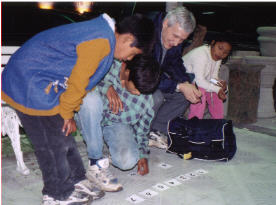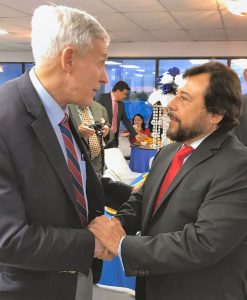Lee Havis, creator of the “Character Teaching” project started the project in Mexico, and since he has been a teacher in Latin America and speak Spanish, he has taken a special interest in developing the project in Latin America. In March, 2014, he recorded an interview on a local Hispanic broadcasting media, asiesmigente.com, which offers in Spanish a brief introduction to the project, which is Spanish is referred to as “Ensenanza del Caracter”.
Mexico

The idea for the Character Teaching (CT) first arose in Mexico in 2000, when Lee Havis, CT founder, was approached by poor working children asking for money on the streets of Las Flores, Mex. a Mexican border town near McAllen, TX. Based on this experience, Lee devised the concept of time-money exchange to create the right conditions for respectful interaction with these children to help develop their qualities of normal character. As part of this concept, he developed certain portable instructional materials to use in this informal street tutoring situation. Later in 2000, he returned to Las Flores to experiment by applying this concept in practice to study its value and effect. (see photo).
This experiment was so successful that Lee developed a more elaborate proposal for funding it on a wide scale through interested private or public agencies. He submitted a specific proposal to the Mexican government, which studied it for several years. Unfortunately, the government of President Vicente Fox, its Ministry of Education, ultimately rejected the CT approach as incompatible with its plan and philosophy of education at that time.
Since 2000, Lee has developed the CT project further to include a formal model school to demonstrate its formal school use, which, after 2003, included the 2003 IMS technology he consolidated at that time. In 2008, he re-submitted a revised and more detailed Spanish language version of the proposal to the new president of Mexico. Originally designed for the US-Mexico border region, it was then proposed on a national scale to operate in any area of the country. Although he received some interest to start the CT project in the northern state of Chihuahua, the project ultimately stalled for lack of local interest and responsible leadership.
Ecuador
In 2004, IMS prepared and submitted a proposal for funding the CT project under a grant from the US Department of Labor, designed to employ education to combat child labor. The project was not approved, receiving a score of only 8 out of 100 possible points. Points were awarded based largely on prior experience in conducting similar projects. The winning contracts were large international NGO’s, such as Catholic Charities, Partners in America, and Save the Children.
Despite this setback, Lee used his failed proposal as the basis for further contact with the Ministry of Education in Ecuador. And, in November, 2009, IMS received a letter of support for the CT project from the Ministry at that time. In view of this favorable support, Lee organized a team of local educators to form a “consultation board” to seek out a sponsor to fund an initial consultation visit in that country. However, to date, the board has been mostly inactive and no such funding sponsor has been found.
Peru
In 2004, after numerous efforts to obtain a letter of support from the president or his Ministry of Education, Lee Havis came into contact with Luis Villegas of Chimbote, who obtained the cooperation and interest of educators in his region, who eventually met and agreed to give support to the project. Sr. Esteban Horna Bances, Rector of the Universidad Nacional del Santa in Chimbote, became leader of the local support group, offering a grant to provide funds from his institution for an initial consultation visit to conduct a training seminar for teachers there. However, due to disagreement on the details of the funding grant, planning for that visit were set aside.
After 2004, there has been no effective further effort to follow up this prior favorable interest. Needed now, therefore, is a local associate who will actively help obtain a letter of support from the president of Peru or his Ministry of Education. Another possible way forward is to obtain a letter of support from Governor of the state of Chimbote, which might then lead to funding of a suitable consultation visit in that state, in conjunction with institutions such as the Universidad Nacional del Santa.
Central America
In 2004, IMS submitted a proposal for funding a CT project with the US Department of Education, focusing on eradicating child labor through education in Central America. Although it was rejected, writing the proposal was an opportunity to contact the various countries in the region, mainly El Salvador, Guatemala, Nicaragua, Honduras, Costa Rica, and Panama.
In 2019, large numbers of citizens from Central American have been traveling through Mexico to seek illegal entry into the United States at its southern border. Ironically, these would-be immigrants are piling up right about the same border town where the CT project began in 2000. Due to lax immigration laws in the US, and poor law enforcement in Mexico, a great strain and cost to the United States is emerging at the southern border. Since the cause of the problem is poor economy and social organization in the countries of Central America, support for the CT project is a logical part of the solution that may well serve all parties involved.
Nicaragua: In 2005, IMS received a splendid letter of support for the CT project from Nicaraguan president Bolanos. However, follow up effort to organize a local leadership team failed for lack of interest among the Nicaraguan people. . After President Bolanos left office, the new president, Daniel Ortega, did not reply to confirm any continuing support for the CT project in his country. So, the project was abandoned and set aside at that time.
El Salvador: In 2004, a number of groups and educators expressed support for the CT project; however, none demonstrated the necessary active effort to pursue a letter of support from the President, or any significant sponsor to assure suitable funding for an initial consultation visit.

In 2017, conditions of illegal immigration from Central America to the US, encouraged IMS to initiate a new effort to explore operating the CT project in that area. And since the population of people from El Salvador was especially high in the area near the IMS office in Silver Spring, MD USA, Lee Havis decided to conduct a series of broadcast interviews and panel shows on local Spanish language news media outlets. In this way, in 2019, Lee was introduced to members of the new administration in El Salvador, including Felix Olluo, the newly elected vice-president. Lee plans to follow up these direct personal contacts to obtain a letter of support from the El Salvador president, and a team of local volunteers to provide support for the initial consultation visit in El Salvador.
Honduras: In 2004, contact was made with a local NGO involved with charity and relief work in education in Honduras. Their interest in working with IMS led to preparation of a proposal to fund a “tutoring center” at their location. However, the agency ultimately rejected the project as ‘too costly’, even though it would have likely received funds from the national government which makes grants for this type of educational activity. [The real reason for the agency’s withdrawal from the project is more likely an issue of lack of understanding and control of the project’s actual operation].
In Honduras, there is a large consortium of international relief organizations who meet regularly each year. The main leader of this consortium is an American of Honduran decent, who writes a newsletter about these efforts. Therefore, this is a possible link to bring participation in the CT project once a suitable coordinator or letter of support can be obtained from the President of the country.
